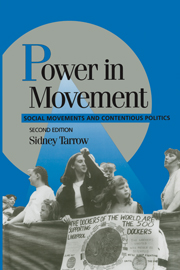Book contents
- Frontmatter
- Contents
- List of Figures
- Preface
- Acknowledgments
- Introduction
- 1 Contentious Politics and Social Movements
- PART 1 THE BIRTH OF THE MODERN SOCIAL MOVEMENT
- PART II FROM CONTENTION TO SOCIAL MOVEMENTS
- PART III THE DYNAMICS OF MOVEMENT
- Conclusion: The Future of Social Movements
- Notes
- Sources
- Index
- CAMBRIDGE STUDIES IN COMPARATIVE POLITICS
Conclusion: The Future of Social Movements
Published online by Cambridge University Press: 05 June 2012
- Frontmatter
- Contents
- List of Figures
- Preface
- Acknowledgments
- Introduction
- 1 Contentious Politics and Social Movements
- PART 1 THE BIRTH OF THE MODERN SOCIAL MOVEMENT
- PART II FROM CONTENTION TO SOCIAL MOVEMENTS
- PART III THE DYNAMICS OF MOVEMENT
- Conclusion: The Future of Social Movements
- Notes
- Sources
- Index
- CAMBRIDGE STUDIES IN COMPARATIVE POLITICS
Summary
In 1789, as word of France's revolution reached England, abolitionist Thomas Clarkson crossed the Channel to urge his French colleagues to join his country's antislavery movement. Clarkson took the same route again in 1814, following a second wave of British agitation. But “twice,” writes the leading American student of antislavery, “he failed utterly” (Drescher 1994).
Two hundred years later, as the French were commemorating the revolution that brought Clarkson to Paris, a new wave of revolution swept over the Communist world. Diffused by word of mouth, by printed page, and, especially, by radio and television, contention spread across the internal boundaries of the collapsing Soviet bloc, enjoying a brief, tragic echo in China, and giving way to savage confrontations in Romania, in the Caucasus, and ultimately in Yugoslavia. Within a year, the state system that had dominated fifty years of European conflict was gone. By 1991, even the Soviet Union, heartland of proletarian internationalism, had imploded, giving way to a galaxy of semidemocratic, semimarket, deeply conflictual societies.
When we compare the rapid diffusion of the movements of 1989 to Clarkson's inability to bring abolitionism across thirty miles of water to a France in full flood of revolution, we can begin to understand the progress made by the social movement over the past two hundred years. For not only did eastern Europeans, Baltic ethnics, and Chinese students rebel en masse: they did so against similar targets, at virtually the same time, and in the name of goals that varied only in their details.
- Type
- Chapter
- Information
- Power in MovementSocial Movements and Contentious Politics, pp. 196 - 210Publisher: Cambridge University PressPrint publication year: 1998

